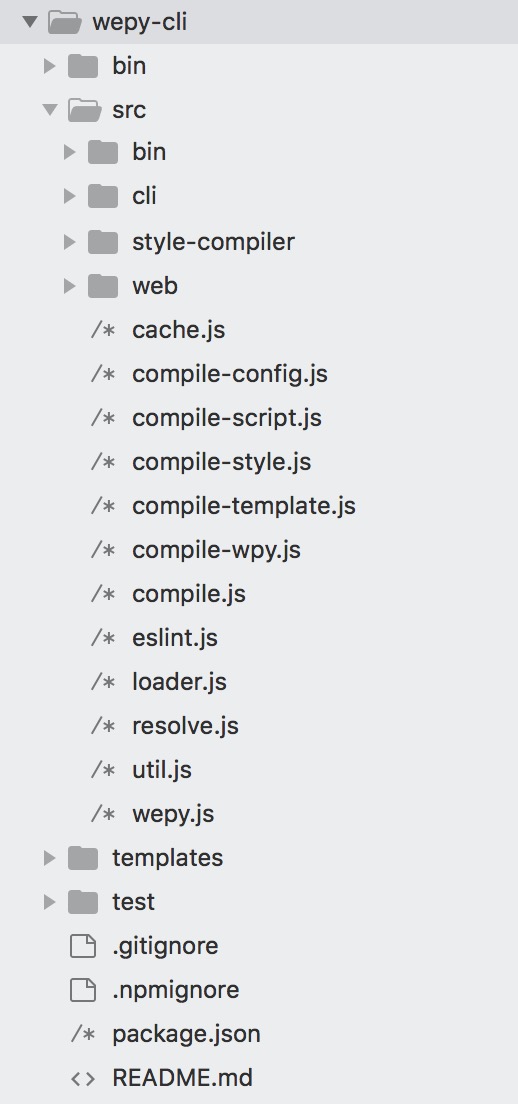深入wepy源码:wpy文件编译过程
yingye opened this issue · 3 comments
wepy 是腾讯开源的一款小程序框架,主要通过预编译的手段,让开发者采用类 Vue 风格开发。 让我们一起看看, wepy 是如何实现预编译的。先放上一张官网的流程图,后面的分析可以参考该图。
wepy-cli 主要负责 .wpy 文件的编译,目录结构如下:
编译的入口是 src/compile.js 中的 compile() 方法,该方法主要是根据文件类型,执行不同的 compiler ,比如 .wpy 文件会走 compile-wpy.js 下的 compile() 方法。
compile(opath) {
...
switch(opath.ext) {
case ext:
cWpy.compile(opath);
break;
case '.less':
cStyle.compile('less', opath);
break;
case '.sass':
cStyle.compile('sass', opath);
break;
case '.scss':
cStyle.compile('scss', opath);
break;
case '.js':
cScript.compile('babel', null, 'js', opath);
break;
case '.ts':
cScript.compile('typescript', null, 'ts', opath);
break;
default:
util.output('拷贝', path.join(opath.dir, opath.base));
...
}
} .wpy文件拆解
compile-wpy.js 下的 compile() 方法,核心调用了 resolveWpy() 方法。
resolveWpy() 方法,主要是将 .wpy 拆解成 rst 对象,并对其中的 template、script 做一些预处理,然后将 template、 script、 style 三部分移交给不同的 compiler 处理。
生成rst对象
通过 xmldom 获取 xml 对象,然后遍历节点,拆解为 rst对象。
import {DOMParser} from 'xmldom';
export default {
createParser (opath) {
return new DOMParser({
...
})
},
...
resolveWpy () {
let xml = this.createParser(opath).parseFromString(content);
}
}rst对象结构如下:
let rst = {
moduleId: moduleId,
style: [],
template: {
code: '',
src: '',
type: ''
},
script: {
code: '',
src: '',
type: ''
}
}; 此外,还对 template 做了如下一些预处理:
pug预编译- 获取文件中的
import,放入rst.template.components中 - 获取
props和events,放入rst.script.code中
compile-template
compile-template.js 中的 compile() 方法,根据 template 的 lang 值,执行不同的 compiler ,比如 wepy-compile-typescript 。编译完成后,执行 compileXML 方法,做了如下的操作:
updateSlot方法: 替换 slot 内容updateBind方法: 在 {{}} 和 attr 上加入组件的前缀,例如:{{width}}->{{$ComponentName$width}}- 把自定义的标签、指令转换为 wxml 语法,例如:
<repeat for="xxx" index="idx" item="xxx" key="xxx"></repeat>
<!-- 转换为 -->
<block wx:for="xxx" wx:for-index="xxx" wx:for-item="xxx" wx:key="xxxx"></block>compile-style
依旧先是根据 lang 值,先执行不同的 compiler ,比如 wepy-compile-less 。编译完成后,执行 src/style-compiler/scope.js 中的 scopedHandler() 方法,处理 scoped 。
import postcss from 'postcss';
import scopeId from './scope-id';
export default function scopedHandler (id, content) {
console.log('id is: ', id)
console.log('css content is: ', content)
return postcss([scopeId(id)])
.process(content)
.then(function (result) {
console.log('css result is: ', result.css)
return result.css
}).catch((e) => {
return Promise.reject(e)
})
}这里主要是利用 add-id 的 postcss 插件,插件源码可参考 src/style-compiler/scope-id.js。根据上面的代码,打印出来的log如下:
最后,会把 requires 由绝对路径替换为相对路径,并在 wxss 中引入,最终生成的 wxss 文件为:
@import "./../components/demo.wxss";
Page{background:#F4F5F7} ... compile-script
依旧先是根据 lang 值,执行不同的 compiler。compiler 执行完之后,判断是否是 npm 包,如果不是,依据不同的 type 类型,加入 wepy 初始化的代码。
if (type !== 'npm') {
if (type === 'page' || type === 'app') {
code = code.replace(/exports\.default\s*=\s*(\w+);/ig, function (m, defaultExport) {
if (defaultExport === 'undefined') {
return '';
}
if (type === 'page') {
let pagePath = path.join(path.relative(appPath.dir, opath.dir), opath.name).replace(/\\/ig, '/');
return `\nPage(require('wepy').default.$createPage(${defaultExport} , '${pagePath}'));\n`;
} else {
appPath = opath;
let appConfig = JSON.stringify(config.appConfig || {});
let appCode = `\nApp(require('wepy').default.$createApp(${defaultExport}, ${appConfig}));\n`;
if (config.cliLogs) {
appCode += 'require(\'./_wepylogs.js\')\n';
}
return appCode;
}
});
}
}接下来会执行 resolveDeps() 方法,主要是处理 requires。根据 require 文件的类型,拷贝至对应的目录,再把 code 中的 require 代码替换为 相对路径。
处理好的 code 最终会写入 js 文件中,文件存储路径会判断类型是否为 npm。
let target;
if (type !== 'npm') {
target = util.getDistPath(opath, 'js');
} else {
code = this.npmHack(opath, code);
target = path.join(npmPath, path.relative(opath.npm.modulePath, path.join(opath.dir, opath.base)));
}plugin
根据上面的流程图,可以看出所有的文件生成之前都会经过 Plugin 处理。先来看一下,compiler 中是如何载入 Plugin 的。
let plg = new loader.PluginHelper(config.plugins, {
type: 'css',
code: allContent,
file: target,
output (p) {
util.output(p.action, p.file);
},
done (rst) {
util.output('写入', rst.file);
util.writeFile(target, rst.code);
}
});其中,config.plugins 就是在 wepy.config.js 中定义的 plugins。让我们来看一下 PluginHelper 类是如何定义的。
class PluginHelper {
constructor (plugins, op) {
this.applyPlugin(0, op);
return true;
}
applyPlugin (index, op) {
let plg = loadedPlugins[index];
if (!plg) {
op.done && op.done(op);
} else {
op.next = () => {
this.applyPlugin(index + 1, op);
};
op.catch = () => {
op.error && op.error(op);
};
if (plg)
plg.apply(op);
}
}
}在有多个插件的时候,不断的调用 next(),最后执行 done()。
编写plugin
wxss 与 css 相比,拓展了尺寸单位,即引入了 rpx 单位。但是设计童鞋给到的设计稿单位一般为 px,那现在我们就一起来编写一个可以将 px 转换为 rpx 的 wepy plugin。
从 PluginHelper 类的定义可以看出,是调用了 plugin 中的 apply() 方法。另外,只有 .wxss 中的 rpx 才需要转换,所以会加一层判断,如果不是 wxss 文件,接着执行下一个 plugin。rpx 转换为 px 的核心是,使用了 postcss-px2units plugin。下面就是设计好的 wepy-plugin-px2units,更多源码可参考 github 地址。
import postcss from 'postcss';
import px2units from 'postcss-px2units';
export default class {
constructor(c = {}) {
const def = {
filter: new RegExp('\.(wxss)$'),
config: {}
};
this.setting = Object.assign({}, def, c);
}
apply (op) {
let setting = this.setting;
if (!setting.filter.test(op.file)) {
op.next();
} else {
op.output && op.output({
action: '变更',
file: op.file
});
let prefixer = postcss([ px2units(this.setting.config) ]);
prefixer.process(op.code, { from: op.file }).then((result) => {
op.code = result.css;
op.next();
}).catch(e => {
op.err = e;
op.catch();
});
}
}
}最后
本文分析的源码以 wepy-cli@1.7.1 版本为准,更多信息可参考 wepy github (即 github 1.7.x 分支)。
欢迎各位关注我的Blog,正文以issue形式呈现,喜欢请点star,订阅请点watch~
能不能编译后的小程序反编译wepy源码?
是的,原生小程序的代码编译成wepy代码,或者有wepy生产的小程序的代码,再反编译到wepy源代码


